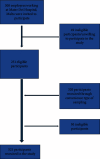Anthropometric and Biochemical Correlations of Insulin Resistance in a Middle-Aged Maltese Caucasian Population
- PMID: 38420511
- PMCID: PMC10901578
- DOI: 10.1155/2024/5528250
Anthropometric and Biochemical Correlations of Insulin Resistance in a Middle-Aged Maltese Caucasian Population
Abstract
Background: Insulin resistance (IR) is associated with increased cardiovascular disease risk, and with increased all-cause, cardiovascular, and cancer mortality. A number of surrogate markers are used in clinical practice to diagnose IR. The aim of this study was to investigate the discriminatory power of a number of routinely available anthropometric and biochemical variables in predicting IR and to determine their optimal cutoffs.
Methods: We performed a cross-sectional study in a cohort of middle-aged individuals. We used receiver operator characteristics (ROC) analyses in order to determine the discriminatory power of parameters of interest in detecting IR, which was defined as homeostatic model assessment-insulin resistance ≥2.5.
Results: Both the lipid accumulation product (LAP) and visceral adiposity index (VAI) exhibited good discriminatory power to detect IR in both males and females. The optimal cutoffs were 42.5 and 1.44, respectively, in males and 36.2 and 1.41, respectively, in females. Serum triglycerides (TG) and waist circumference (WC) similarly demonstrated good discriminatory power in detecting IR in both sexes. The optimal cutoffs for serum TG and WC were 1.35 mmol/L and 96.5 cm, respectively, in men and 1.33 mmol/L and 82 cm, respectively, in women. On the other hand, systolic and diastolic blood pressure, liver transaminases, high-density lipoprotein cholesterol, serum uric acid, ferritin, waist-hip ratio, "A" body shape, thigh circumference, and weight-adjusted thigh circumference all had poor discriminatory power.
Conclusions: Our data show that LAP, VAI, TG, and WC all have good discriminatory power in detecting IR in both men and women. The optimal cutoffs for TG and WC were lower than those currently recommended in both sexes. Replication studies are required in different subpopulations and different ethnicities in order to be able to update the current cut points to ones which reflect the contemporary population as well as to evaluate their longitudinal relationship with longer-term cardiometabolic outcomes.
Copyright © 2024 Rachel Agius et al.
Conflict of interest statement
The authors declare that they have no conflicts of interest.
Figures




Similar articles
-
LIPID ACCUMULATION PRODUCT, VISCERAL ADIPOSITY INDEX, AND CHINESE VISCERAL ADIPOSITY INDEX AS MARKERS OF CARDIOMETABOLIC RISK IN ADULT GROWTH HORMONE DEFICIENCY PATIENTS: A CROSS-SECTIONAL STUDY.Endocr Pract. 2018 Jan;24(1):33-39. doi: 10.4158/EP-2017-0007. Epub 2017 Nov 16. Endocr Pract. 2018. PMID: 29144802
-
Usefulness of four surrogate indexes of insulin resistance in middle-aged population in Hefei, China.Ann Med. 2022 Dec;54(1):622-632. doi: 10.1080/07853890.2022.2039956. Ann Med. 2022. PMID: 35175162 Free PMC article.
-
Lipid accumulation product and triglycerides/glucose index are useful predictors of insulin resistance.J Diabetes Complications. 2018 Mar;32(3):266-270. doi: 10.1016/j.jdiacomp.2017.10.007. Epub 2017 Oct 21. J Diabetes Complications. 2018. PMID: 29395839
-
Comparison of Novel Biomarkers of Insulin Resistance With Homeostasis Model Assessment of Insulin Resistance, Its Correlation to Metabolic Syndrome in South Indian Population and Proposition of Population Specific Cutoffs for These Indices.Cureus. 2023 Jan 11;15(1):e33653. doi: 10.7759/cureus.33653. eCollection 2023 Jan. Cureus. 2023. PMID: 36788883 Free PMC article.
-
[Associations Between Insulin Resistance Indexes and Hyperuricemia in Hypertensive Population].Zhongguo Yi Xue Ke Xue Yuan Xue Bao. 2023 Jun;45(3):390-398. doi: 10.3881/j.issn.1000-503X.15414. Zhongguo Yi Xue Ke Xue Yuan Xue Bao. 2023. PMID: 37407524 Chinese.
Cited by
-
Relationship between the Mediterranean Diet and Vascular Function in Subjects with and without Increased Insulin Resistance.Nutrients. 2024 Sep 14;16(18):3106. doi: 10.3390/nu16183106. Nutrients. 2024. PMID: 39339706 Free PMC article.
References
-
- Pan K., Nelson R. A., Wactawski-Wende J., et al. Insulin resistance and cancer-specific and all-cause mortality in postmenopausal women: the women’s health initiative. Journal of the National Cancer Institute: Journal of the National Cancer Institute . 2020;112(2):170–178. doi: 10.1093/jnci/djz069. - DOI - PMC - PubMed
LinkOut - more resources
Full Text Sources
Research Materials
Miscellaneous

